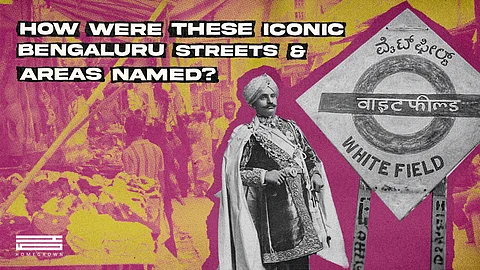
- HOMEGROWN WORLD
- #HGCREATORS
- #HGEXPLORE
- #HGVOICES
- #HGSHOP
- CAREERS
- ABOUT US
- CONTACT US

Once you have lived in a city long enough, remembering the names of streets, junctions, and localities is no big deal. Each location, however, is named (and perhaps renamed) owing to certain influences. The most common way to name areas is to use cultural influences including names of prominent people – probably why you see an MG (Mahatma Gandhi) Road in almost every city in the country.
The beauty, we believe, lies in the more unknown tales of how areas and streets came to be named. Each city has their own ‘inside secret’ for the name of a popular spot, possibly completely unrelated to its original name. How romantic is it to think that we adore our cities to an extent that we collectively assign endearing names to their areas?
Along with this, many spots are named through history with peculiar stories. Not based on a person or geography, but instances in time that defined the surroundings.
A mix of these two types is what makes the city of Bengaluru. With several difficult-to-pronounce areas (if you are not a long-time resident) and many simple names of locations, the city is home to streets and spots whose history is no less than an interesting tale to tell.
I. Domlur
Now a popular place among tech employees, Domlur is home to several IT corporations and MNCs.
There exist two beliefs behind how Domlur was named, both just as intriguing as the other. Some believe the name has been derived from the Kannada word Tombalur, a variety of flowers used to worship Lord Shiva. The other theory states that the area was once infamous for how it was densely populated by mosquitoes. Domalu, the Telugu word for mosquito, served as the basis of the name. Thus, in combination with ooru (a village/town in Kannada), the name Domlur was assigned.
II. Indiranagar, Sony Signal
Indiranagar is one of the most famous areas of Bengaluru. From residences to cafes, and pubs to luxury shops; everything is present here.
Along the 100 Foot Road in Indiranagar exists a traffic signal more popularly known as ‘Sony Signal’. This is so because there once was a Sony showroom at the junction, accompanied by a large Sony billboard overhead - one that was impossible to miss. Since it was such a prominent landmark, the signal was unofficially named after it. The showroom has since shut down, and the billboard no longer exists, but Sony Signal lives on.
III. Indiranagar KFC
This iconic spot in the city is demarcated by the presence of a KFC outlet in the popular area of Indiranagar. While the actual address does not involve ‘KFC’, the outlet has come to be a well-known landmark, with a designated bus stop named after it, too. Its actual location is Stage 1, CMH Road, but why bother when KFC does the job?
What happens if and when the KFC outlet shuts down, you ask? Perhaps, it will follow the same fate as that of the Sony Signal.
IV. Kodigehalli
The Kannada word Kodige translates to a ‘gift’ or ‘offer’. Halli is the Kannada word for ‘village’ and suffixes the names of several areas across the city. The area of Kodigehalli is allegedly a gift from King Veera Ballala of the Hoysala Empire to a resident who offered him a meal.
V. Malleshwaram
Located in the North-West of Bengaluru, this area has a simple past – the Kaadu Malleshwara Temple is situated there, and the area took its name from there.
VI. Marathahalli
The HAL HF-24 Marut was a fighter-bomber aircraft made by Hindustan Aeronautical Limited (HAL) in Bengaluru. It was designed and assembled near the area, which is how the name Marathahalli was born (Marut + Halli). Some believe that it was named so because Marut unfortunately crashed in the area, giving it its name.
VII. Mission Road
Very simply, Missionary Road is named after the London Missionary Society that has existed in Bengaluru since the 1820s.
VIII. Nagarbhavi
When translated from Kannada to English, Naga means ‘snake’ and Bhavi means ‘well’ – Nagarbhavi thus translates to a ‘well of snakes’ because before the area was urbanised, a large population of snakes occupied it. It is also believed that due to the presence of hillocks around Nagarbhavi, the area takes the shape of a well, lending to its name.
IX. Ulsoor
When the Kannada word for jackfruits, halasu, is combined with ooru (village), we get the name Halasuru, also referred to as Ulsoor. This area had a widespread jackfruit orchard, and hence, ‘jackfruit village’ came to be.
X. Whitefield
Up till the year 1882, the region of Whitefield was scarcely inhabited. In the coming years, the ruler of Mysore, His Highness Chamaraja Wodeyar IX, gave a portion of the land away to the Eurasian and Anglo Indian Association, which (quite obviously) consisted of people with white skins and that’s how Whitefield came to be.
If you enjoyed reading this, we suggest you also read:
